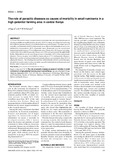| dc.contributor.author | Kagira, J | |
| dc.contributor.author | Kanyari, P.W.N | |
| dc.date.accessioned | 2013-06-13T15:20:35Z | |
| dc.date.available | 2013-06-13T15:20:35Z | |
| dc.date.issued | 2001 | |
| dc.identifier.citation | J. Kagira, P.W.N. Kanyari (2001). The role of parasitic diseases as causes of mortality in small ruminants in a high-potential farming area in central Kenya. J S Afr Vet Assoc; Vol 72, No 3 (2001), 147-149 | en |
| dc.identifier.uri | http://jsava.co.za/index.php/jsava/article/view/638 | |
| dc.identifier.uri | http://erepository.uonbi.ac.ke:8080/xmlui/handle/123456789/33361 | |
| dc.description.abstract | A 15-year retrospective study was performed to determine the role of parasitic diseases in causing mortalities in small ruminants. In total, 115 (32 %) sheep were diagnosed as having been killed by parasitic diseases out of 366 that died as a result of disease. The major cause of mortality was helminthosis (63 %of all parasitic cases). Most of the helminthosis cases were attributed to haemonchosis (40 % of parasitic cases). Heartwater was the second most important parasitic disease (27 %of all parasitic cases). Ninety-five (26 %) goats were diagnosed to have been killed by parasitic diseases out of 365 cases presented at the post mortem facility. Helminthosis was the most frequent cause of mortality (55 % of the total parasitic diseases). Twenty-six goats were killed by haemonchosis (27 % of all parasitic diseases). Heartwater was the second most important parasitic disease, accounting for about 20 % of all parasitic diseases. These findings indicate that viable helminth and tick control strategies should be devised in order to reduce mortality caused by helminthosis and heartwater and thereby achieve improved productivity. | en |
| dc.language.iso | en | en |
| dc.title | The role of parasitic diseases as causes of mortality in small ruminants in a high-potential farming area in central Kenya | en |
| dc.type | Article | en |

